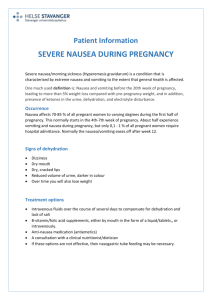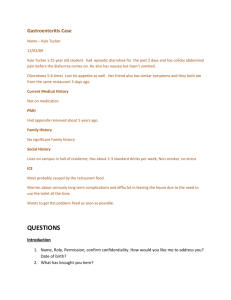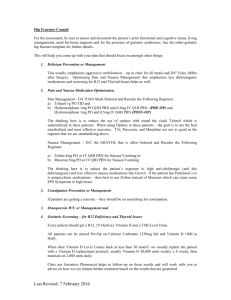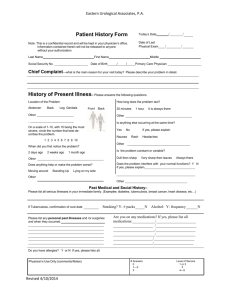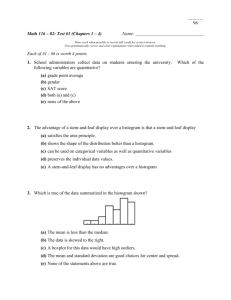the Survey Treatments With Negative
advertisement
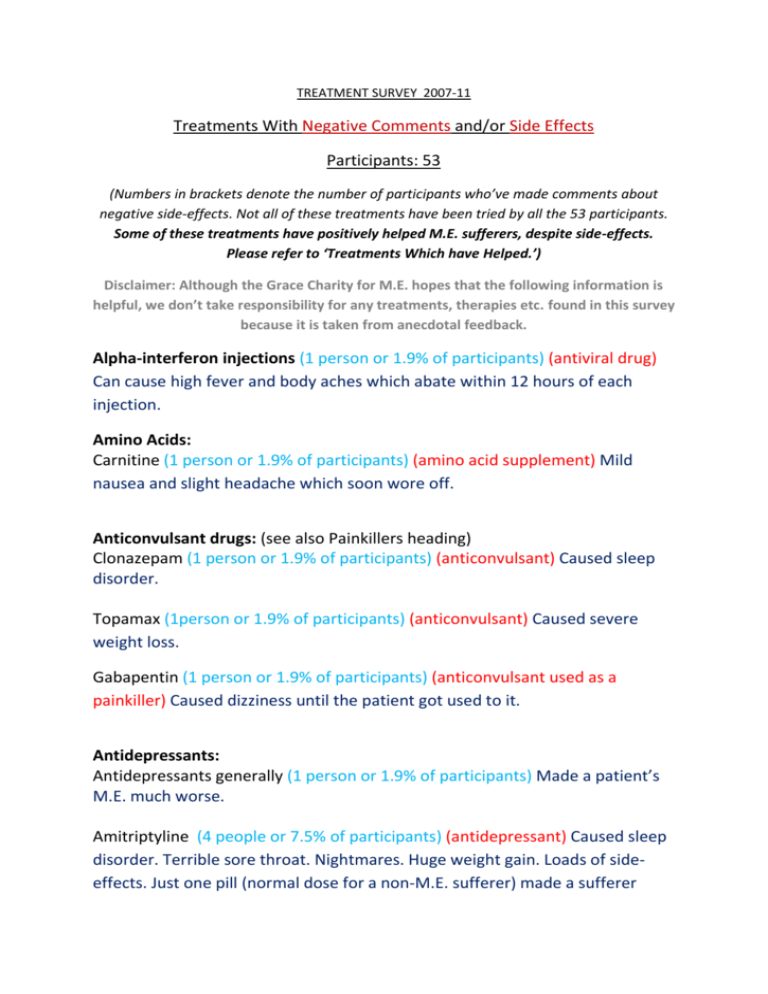
TREATMENT SURVEY 2007-11 Treatments With Negative Comments and/or Side Effects Participants: 53 (Numbers in brackets denote the number of participants who’ve made comments about negative side-effects. Not all of these treatments have been tried by all the 53 participants. Some of these treatments have positively helped M.E. sufferers, despite side-effects. Please refer to ‘Treatments Which have Helped.’) Disclaimer: Although the Grace Charity for M.E. hopes that the following information is helpful, we don’t take responsibility for any treatments, therapies etc. found in this survey because it is taken from anecdotal feedback. Alpha-interferon injections (1 person or 1.9% of participants) (antiviral drug) Can cause high fever and body aches which abate within 12 hours of each injection. Amino Acids: Carnitine (1 person or 1.9% of participants) (amino acid supplement) Mild nausea and slight headache which soon wore off. Anticonvulsant drugs: (see also Painkillers heading) Clonazepam (1 person or 1.9% of participants) (anticonvulsant) Caused sleep disorder. Topamax (1person or 1.9% of participants) (anticonvulsant) Caused severe weight loss. Gabapentin (1 person or 1.9% of participants) (anticonvulsant used as a painkiller) Caused dizziness until the patient got used to it. Antidepressants: Antidepressants generally (1 person or 1.9% of participants) Made a patient’s M.E. much worse. Amitriptyline (4 people or 7.5% of participants) (antidepressant) Caused sleep disorder. Terrible sore throat. Nightmares. Huge weight gain. Loads of sideeffects. Just one pill (normal dose for a non-M.E. sufferer) made a sufferer extremely ill and unable to move for 48 hours, worsening M.E. symptoms for one month. Cymbalta (1 person or 1.9% of participants) (antidepressant) Caused extreme nausea. Seroxat (1 person or 1.9% of participants) (antidepressant) Not specific in how it affected this person. SSRI drugs (generally) (1 person or 1.9% of participants) (antidepressants) Not specific in how it affected this person. Antibiotics (high dose) (1 person or 1.9% of participants) ‘Completely wiped out’ a patient, with the bugs still present after the high dose. Aromatherapy (1 person or 1.9% of participants) (herbal massage oils) If too intense can worsen symptoms. Buspirone (1 person or 1.9% of participants) (anti-anxiety drug) Not specific in how it affected this person. CBT (4 people or 7.5% of participants) (Cognitive Behavioural Therapy) Caused relapse. Of no benefit after 2 courses. Co Q 10 (1 person or 1.9% of participants) (enzyme supplement) Mild nausea and slight headache which soon wore off. Counsellors (inexperienced) (1 person or 1.9% of participants) Not specific in how it affected this person. Diet (1 person or 1.9% of participants) Wheat, diary produce and sugar made one sufferer worse. D- Ribrose (1 person or 1.9% of participants) (supplement) Mild nausea and slight headache which soon wore off. E.C.T. (1 person or 1.9% of participants) (electroconvulsive therapy) Not specific in how it affected this person. Essential Fatty Acids: Veg EPA (1person or 1.9% of participants) (supplement) Mild nausea and headache which soon wore off. Fungilin (1 person or 1.9% of participants) (antifungal drug) Not specific in how it affected this person. Graded Exercise (5 people or 9.4% of participants) Caused relapse. Of no benefit after two courses. Worsened illness significantly. ‘Worse thing an M.E. sufferer can do.’ ‘For the first month it was terribly difficult and made me feel worse.’ Had adverse effects on health. High Dose Vitamin C (1 person or 1.9% of participants) Not specific in how it affected this person. Imigran (1 person or 1.9% of participants) (drug for migraine) Caused extreme tiredness. Lithium (1 person or 1.9% of participants) (drug for manic depression) Was given to a patient before an M.E. diagnosis. Made her blind and caused severe weight loss. Magnesium (1 person or 1.9% of participants) (mostly by injections) Mild nausea and slight headache which soon wore off. Massage (1 person or 1.9% of participants) Intense massage can make things worse and, if too heavy, a massage can exacerbate leg pain. Mestinon (1 person or 1.9% of participants) (drug used to improve muscle strength especially for Myasthenia Gravis) Side effects reported of severe cardiac problems, necessitating complete bed rest. Mickel Therapy (1 person or 1.9% of participants) (Mind/body reprogramming) Sufferer thought she was cured from M.E. as she suddenly felt better but the M.E. returned as she upped her activity levels. Midodrine (1 person or 1.9% of participants. It is a named patient drug, signed for by a consultant.) (Treats low blood pressure. Useful with POTS, increase in heart rate due to an upright position) Reports of overly excited autonomic nervous system, e.g. supine hypertension (high blood pressure when lying down.) Miguard (1 person or 1.9% of participants) (5HT receptor agonist, used as a painkiller for migraine) Caused extreme tiredness. Nimodipine (1 person or 1.9% of participants) (calcium channel blocker, acting on arterial wall muscles preventing constriction. Used in M.E. to increase cellular mitochondrial energy, increase blood flow to the brain and repair neurochemical transmission) A patient comments that on the 4th day of taking this, she had slight nausea and smelly perspiration but these left within 24 hours and didn’t return. Ozone Therapy (1 person or 1.9% of participants) (oxygenates body tissue) Tiring due to treatment of detoxing. Pacing, (over zealous) (2 people or 3.8% of participants) Lack of social life. A hospital pacing programme pushed a sufferer ‘over the top’, making her worse. Painkillers: (see also Anticonvulsant drug heading) Buprenorphine patches (1 person or 1.9% of participants) (painkiller patches used for fibromyalgia) Patient said it was a difficult drug to live with. Celebrex (1 person or 1.9% of participants) (painkiller) Caused fluid retention and oedema. Tramadol (1 person or 1.9% of participants)(opioid painkiller) Caused dizziness and sleep disorder. Oxycodone (1 person or 1.9% of participants) (opioid painkiller) Gave nausea and dizziness. Fentanyl (1 person or 1.9% of participants) (opioid painkiller) Occasionally produced a localised rash from the patches. Propranolol (1 person or 1.9% of participants)(anti-anxiety drug) Slowed down heart rate too much. Psychotic Drugs (generally) (3 people or 5.7% of participants) Comments such as ‘appalling’ reactions. Septrin (1 person or 1.9% of participants)(antibiotic) Not specific how it affected this person. Temazepam (1 person or 1.9% of participants)(sleeping pill) Caused severe head pains on sitting up and standing, stomach pains, suppressed breathing, dizziness, nausea TOP TEN TREATMENTS WITH NEGATIVE COMMENTS AND/OR SIDE-EFFECTS (UPDATED 13/9/11) 1) 2) 3) 4) 5) Graded Exercise CBT/ /Amitriptyline Psychotic Drugs Over zealous pacing All others listed above have one complaint only ADDITIONAL PATIENTS SINCE THE 53 PARTICIPANTS ,FROM SEPTEMBER 2011, WITH NEGATIVE COMMENTS OR SIDE-EFFECTS REGARDING THE TREATMENTS ABOVE AND NEW TREATMENTS. Patient No.54, male: Reported that stress made him worse. Patient No. 55, female: Hydrotherapy almost killed her. It made her hypoglycaemic, at point of collapse and taking days to recover. She says that you should only do vertical hydrotherapy but she was made to lie on her back and walk up and down the pool. Patient No.59, male: Amitriptyline: horrible sedation on the smallest dose/ Nortriptyline: same as amitriptyline/ Gabapentin: nausea, fatigue. Dopamine agonists, including pramipexole and rotigotine patches: side-effects including nausea, stuffy nose and fatigue. Tramadol (unhelpful), Dosulepine (unhelpful), Doloxetine: nausea and fatigue. Prozac: drove him to exhaustion. Clonazepam (Klonopin) depressed him and may have suppressed his respiration. Evening Primrose Oil gave him nasty headaches. Vitamin D made him feel sick. Hydrocortisone worsened his sleep. Thyroid hormones, e.g. T4, armour thyroid and T3 made him feel worse with diarrhoea and fatigue. Patient No.60, female: Graded exercise made her worse; she was a mild M.E. sufferer but after graded exercise she became wheelchair bound.
